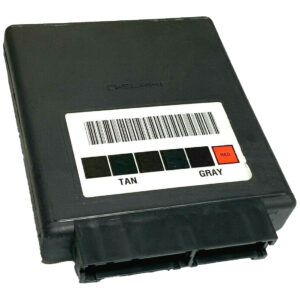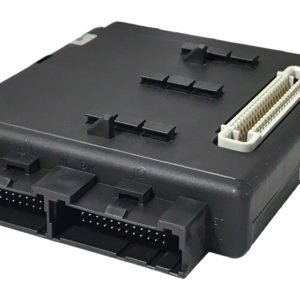Restore Control and End Electrical Frustration in Your GM SUV
Are you chasing down bizarre electrical issues in your Trailblazer, Envoy, or Rainier? One minute the power windows work, the next they don’t. The radio acts possessed, the lights flicker, or worse, the vehicle won’t start at all. As a technician with over 20 years of experience, I’ve seen these exact symptoms hundreds of times, and they almost always point to one component: a failing Body Control Module (BCM). This module is the central hub for your vehicle’s body electronics, and when it fails, it creates chaos. This isn’t just an inconvenience; it can be a serious safety issue when lights or door locks fail unexpectedly.
This isn’t just a replacement part; it’s a complete, ready-to-install solution. We take the guesswork and high costs out of the repair by programming this 2002-2005 Trailblazer BCM to your vehicle’s specific VIN before it ships. This means you can bypass the expensive trip to the dealership for programming. Simply provide your VIN at checkout, and we’ll handle the rest, loading the latest GM software to ensure optimal performance and compatibility.
A Technician’s Notebook: The Case of the Haunted Envoy
I remember a 2004 GMC Envoy that came into my bay with a laundry list of complaints from the owner. The interior lights would stay on, the driver’s window was stuck down, and the security light was flashing intermittently, causing a no-crank condition. The owner had already replaced the battery and checked all the fuses. A scan tool showed a dozen communication error codes (U-codes), which can send you down a diagnostic rabbit hole. Instead of wasting hours checking every wire, my experience pointed straight to the BCM. We swapped in a pre-programmed unit, and like magic, every single issue was resolved instantly. This is a classic failure pattern for these otherwise reliable SUVs.
Is Your SUV Exhibiting These Electrical Gremlins?
A failing BCM can manifest in numerous ways. If you’re experiencing any of the following, this module is the likely solution:
- ✔ Power windows, door locks, or mirrors operating erratically or not at all.
- ✔ Interior or exterior lights flickering, staying on, or not turning on.
- ✔ Instrument cluster gauges behaving strangely or warning lights appearing for no reason.
- ✔ The radio or climate control system malfunctioning.
- ✔ A no-start or no-crank condition, sometimes accompanied by a security light.
- ✔ Diagnostic trouble codes (DTCs) related to communication loss, such as U0140, U0155, or U0164.
- ✔ Inconsistent operation of the rear wiper or liftgate functions.
Your Straightforward BCM Installation Guide
For most of the compatible vehicles, this is a very accessible DIY job. The BCM is integrated into the under-hood fuse block assembly, making it easy to locate and replace.
- Safety First: Always disconnect the negative terminal from your vehicle’s battery and wait a few minutes before beginning work.
- Locate the Module: Open the hood and find the main fuse box, typically located on the driver’s side of the engine bay.
- Access the BCM: Remove the fuse box cover. The BCM is the computer module attached to the side or bottom of this fuse block. You may need to unclip the entire fuse block assembly to access the BCM’s connectors.
- Disconnect and Remove: Carefully unplug the electrical connectors from the old BCM. They have locking tabs that need to be depressed or lifted. Once disconnected, unbolt or unclip the old module from the fuse block.
- Install the New BCM: Secure your new, pre-programmed BCM in place and firmly reconnect all electrical connectors until they click. Re-secure the fuse block assembly and replace the cover.
- Final Steps: Reconnect the negative battery terminal. Start the vehicle to confirm that the primary functions are restored.
Important Post-Installation Note: While our programming handles the majority of the setup, some vehicles may require additional sync procedures. If your airbag light is on, a professional scan tool is needed to perform the ‘Setup SDM Primary Key in BCM’ procedure. Additionally, a ‘Brake Pedal Position Relearn’ may be necessary on certain models to ensure proper brake light and traction control operation.
Verified Fitment for Your GM, Isuzu, or Saab SUV
This Body Control Module is a direct-fit replacement for the following vehicles and part numbers. Please ensure your vehicle is on this list and does not have a factory security system for proper compatibility (unless it is a 2002 model).
Replaces Part Numbers: 15122670, 15065293, 15114669, 15191621, 9352135
- ✔ Buick Rainier: 2004-2005
- ✔ Chevrolet Trailblazer & Trailblazer EXT: 2002-2005
- ✔ GMC Envoy, Envoy XL, & Envoy XUV: 2002-2005
- ✔ Isuzu Ascender: 2003-2005
- ✔ Oldsmobile Bravada: 2002-2004
- ✔ Saab 9-7X: 2005
Frequently Asked Questions
Do I need to do any programming myself?
No. We handle all the programming before we ship the part. Just provide your vehicle’s 17-digit VIN during or after checkout, and it will arrive ready to install.
Is there a core charge or do I need to return my old BCM?
There is absolutely no core charge. You can keep your old part.
What tools are required for installation?
For most models, you’ll only need basic hand tools, such as a socket set or wrench to disconnect the battery and potentially unbolt the fuse block. No special electronic tools are required for the physical installation.
My airbag light came on after installing the new BCM. Is it defective?
No, this is a known possibility. The new BCM needs to be electronically ‘introduced’ to the airbag’s computer (SDM). This requires a ‘Setup SDM Primary Key in BCM’ procedure with a bi-directional scan tool, which most professional repair shops can perform.
Will this 2002-2005 Trailblazer BCM fix my no-start problem?
If the no-start is caused by the BCM failing to recognize the key or communicate with other modules (a common failure), then yes, this part is very likely to solve the issue.
What if I have a different part number on my original module?
This module is a direct replacement for several part numbers, including 15122670, 15065293, 15114669, 15191621, and 9352135. As long as your original part number is on this list and your vehicle matches the fitment chart, it will work correctly.





